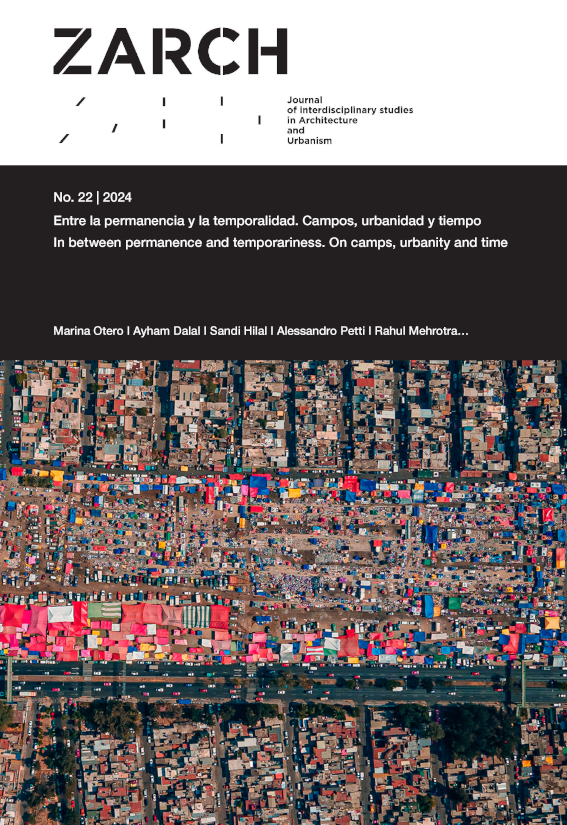Amman: Reading the city through displacement
DOI:
https://doi.org/10.26754/ojs_zarch/zarch.20242210343Keywords:
Amman, displacement, syrian refugees, informal settlements, socioeconomic divideAbstract
Amman is a city shaped by multiple displacements. In 1952 and 1955, two refugee camps, called Al-Hussein and Al-Wihdat, respectively, were established for displaced Palestinians near the city centre. Shortly after, the city began to experience rapid growth due to continuous waves of displacements. A few years later, the camps blended with the emergent urban fabric of the city. This paper elucidates this urban transformation and how it led to the polarization of the city into two sides: the impoverished east dictated by informal arrangements and the rich west with formal support structures. After 2011, Jordan received Syrian refugees, many of whom settled in Amman. This paper discusses the following question: how did Amman grow vis-à-vis displacement? And considering the relatively recent arrival of Syrians to the city (in comparison with other refugees), how did they encounter the city and navigate its socioeconomic disparities? Building on fieldwork conducted in Amman in 2022-23, the author shows how Syrians were split between the two parts of the city, and how those with fewer resources ended up living in the east with its Palestinian camps, while those who have more resources struggle to survive in west Amman.
Downloads
References
Ababsa, Myriam. ‘Public Policies Toward Informal Settlements in Jordan (1965–2010)’. In Popular Housing and Land Tenure in the Middle East, edited by Myriam Ababsa, Baudouin Dupret, and Eric Denis, 259–82. Cairo: The American University in Cairo Press, 2012.
Abourahme, Nasser. ‘Assembling and Spilling-Over: Towards an “Ethnography of Cement” in a Palestinian Refugee Camp’. International Journal of Urban and Regional Research 39, no. 2 (2015): 200–217. https://doi.org/10.1111/1468-2427.12155.
Abu-Dayyeh, Nabil. ‘Persisting Vision: Plans for a Modern Arab Capital, Amman, 1955–2002’. Planning Perspectives 19, no. 1 (2004): 79–110. https://doi.org/10.1080/0266543042000177922.
Agier, Michel. ‘Between War and City: Towards an Urban Anthropology of Refugee Camps’. Ethnography, 2002.
Al Majali, Solenn. ‘Interactions et Altérités Des Réfugiés Subsahariens En Jordanie’. Civilizations 68 (2019): 95–115.
Al-Husseini, Jalal. ‘The Management of the Palestinian Refugee Camps in Jordan between Logics of Integration and Exclusion’. SSRN Electronic Journal, 2010. https://doi.org/10.2139/ssrn.2166837.
Chatelard, Geraldine. ‘Jordan: A Refugee Haven’, 2010. https://hal-confremo.archives-ouvertes.fr/halshs-00514403/.
Daher, Rami. ‘Understanding Cultural Change and Urban Transformation Qualifying Amman: The City of Many Hats’. In Cities, Urban Practices and Nation Building in Jordan, edited by Myriam Ababsa and Rami Daher, 65–89. Presses de l’Ifpo, 2011.
Dalal, Ayham. ‘The Refugee Camp as Site of Multiple Encounters and Realizations’. Review of Middle East Studies 54, no. 2 (December 2020): 215–33. https://doi.org/10.1017/rms.2021.10.
DOS. Population and Housing Census 2004. Amman: Department of Statistics, 2004.
Hamarneh, Ala. ‘The Social and Political Effects of Transformation Processes in Palestinian Refugee Camps in the Amman Metropolitan Area (1989-99)’. In Jordan in Transition, 172–89. Hurst & Co, 2002.
———. ‘Transformation of Al-Wihdat Refugee Camp’. ISIM Newsletter, 2002, 15–15.
Jubeihi, Mazen. ‘Jabal Al-Hussein Refugee Camp’, 2024. https://www.palquest.org/en/highlight/35142/jabal-al-hussein-refugee-camp.
Kreichauf, René, and Birgit Glorius. ‘Introduction: Displacement, Asylum and the City – Theoretical Approaches and Empirical Findings’. Urban Geography 42, no. 7 (2021): 869–93. https://doi.org/10.1080/02723638.2021.1978220.
Malkki, Liisa H. ‘Speechless Emissaries: Refugees, Humanitarianism, and Dehistoricization’. Cultural Anthropology, 1996.
Maqusi, Samar. ‘“Space of Refuge”: Negotiating Space with Refugees Inside the Palestinian Camp’. Humanities 6, no. 3 (2017): 60. https://doi.org/10.3390/h6030060.
Munif, Abdelrahman. سيرة مدينة: عمان في الآربعينيات. 6th ed. المؤسسة العربية للدراسات و النشر & دار التنوير للطباعة و النشر, 2018.
Oesch, Lucas. ‘The Refugee Camp as a Space of Multiple Ambiguities and Subjectivities’. Political Geography 60 (2017): 110–20. https://doi.org/10.1016/j.polgeo.2017.05.004.
Parker, Christopher. ‘Tunnel-Bypasses and Minarets of Capitalism: Amman as Neoliberal Assemblage’. Political Geography 28, no. 2 (2009): 110–20. https://doi.org/10.1016/j.polgeo.2008.12.004.
Shami, Seteney. ‘“Amman Is Not a City”: Middle Eastern Cities in Question’. In Urban Imaginaries: Locating the Modern City, edited by Alev Çınar and Thomas Bender, 209–35. University of Minnesota Press, 2007.
Tiltnes, Åge A., and Huafeng Zhang. ‘The Socio-Economic Conditions of Jordan’s Palestinian Camp Refugees: Summary of Findings from Two Surveys’. Oslo: Fafo, 2014. https://www.fafo.no/images/pub/2014/20394-web-ENG.pdf.
UN-Habitat. ‘Amman Spatial Profile’. Amman: UN-Habitat, 2022.
UNRWA. ‘Amman New Camp’, 2022. https://www.unrwa.org/where-we-work/jordan/amman-new-camp.
Downloads
Published
How to Cite
Issue
Section
Funding data
-
Horizon 2020
Grant numbers 101004539


